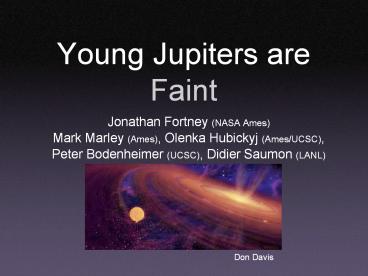Young Jupiters are Faint PowerPoint PPT Presentation
1 / 20
Title: Young Jupiters are Faint
1
Young Jupiters are Faint
- Jonathan Fortney (NASA Ames)
- Mark Marley (Ames), Olenka Hubickyj (Ames/UCSC),
- Peter Bodenheimer (UCSC), Didier Saumon (LANL)
Don Davis
2
- Review evolution at young ages
- Nucleated collapse models (Core accretion Gas
capture) - Alternate early evolution
- Other detectability issues
3
Arbitrarily Hot Start
Teff (K)
log Age (Gyr)
Burrows et al. 2001
4
(No Transcript)
5
Early Model Evolution
- Initial conditions are uncertain
- initial radii too large for smallest masses
- collapse accretion not spherical
- ...assigning an age to objects younger than a
few Myr is totally meaningless when the age is
based on models using oversimplified initial
conditions. Baraffe et al. (2003) - When can the models be trusted?
- Can initial conditions be improved?
6
Nucleated Collapse Model
- Model for accretion of giant planets
- 10 to 20 M? core forms first, initiates collapse
of nebula - Time to gas runaway sensitively depends on
atmospheric opacity - Peak accretion luminosity, created by shock, is
short lived - Gives initial boundary condition for subsequent
evolution
Hubickyj, Bodenheimer Lissauer (2005)
7
(No Transcript)
8
Deviations are greater at larger masses
9
Arbitrarily hot start overestimates radius and
under- estimate gravity at all masses
10
How long is the formation time?
- Opacity of proto-atmosphere affects formation
time, as does surface density of the nebula - Only Podolak (2003) has tried to calculate the
opacity of the proto-atmospheres during formation - When does t 0?
- Agreement with standard cooling models is even
worse if one assigns t0 to the post-formation
time
Hubickyj, et al (2005)
11
A Potential Application 2M1207 Companion
- Companion to M8 brown dwarf in TW Hydrae (age
8 Myr) - red J-K implies late L, Teff 1250 K
- Models give M 5 2 MJup
Chauvin et al. (2004)
12
Teff (K)
log Age (Gyr)
Burrows et al. 1997
13
Real mass closer to 10 MJ ?
14
Similar Problem for Other Objects?
AB Dor C
Reiners et al. (2005) young M star
Close et al. (2005) young M star Mohanty et
al. (2004a,b) Comparisons with hi-res
spectra Masses down to deuterium burning
limit Zapatero Osorio et al. (2004) Dynamical
masses of GJ 569 Bab brown dwarfs
15
Moral
- Discern mass from g, Teff indicators in spectra
colors, not luminosity at young ages (This was
just done for GQ Lup b) - (Of course, this isnt always easy)
log g 5.5
log g 4
from Knapp et al. (2004)
16
Which Bandpasses to Search?
Jupiters M band flux has stories to tell!
M band Jupiter image courtesy Glenn Orton
17
Nonequilibrium CO dims M band
Saumon et al. 2003
18
Saumon et al. 2003
19
L May Be Comparable to M
L
20
Conclusions
- Luminosity of young giant planets depends
sensitively on initial conditions - Nucleated collapse models are cooler, dimmer, and
smaller than generic hot start evolution
calculations. Differences... - persist longer than a few million years
- are more significant at larger masses
- Use of hot start evolution may result in
substantially underestimating mass of observed
objects, depending on actual formation mechanism

